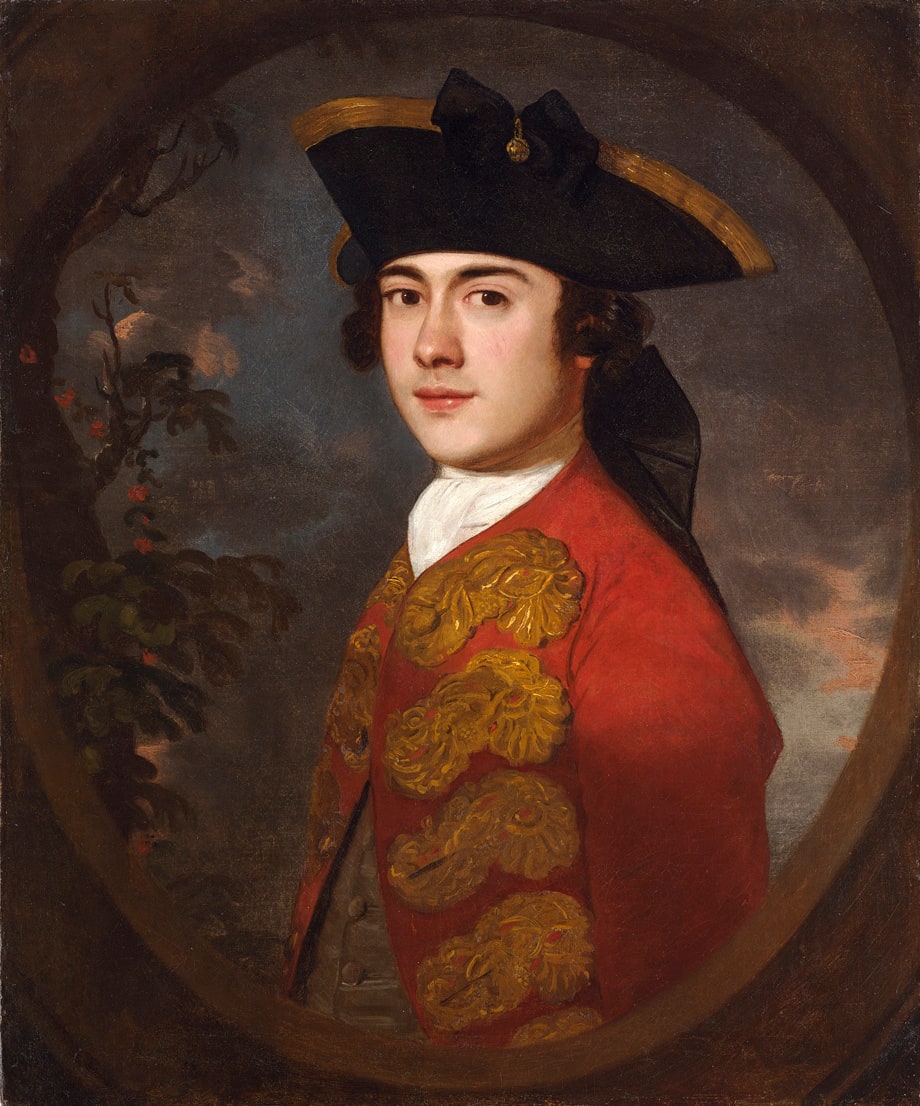
Sir Joshua Reynolds P.R.A.
Portrait of a Gentleman in a Red Jacket, Mid 1740s
Oil on canvas
30 x 25 inches (76 x 63.5 cm)
Philip Mould & Co.
To view all current artworks for sale visit philipmould.com This portrait is an early work by one of Britain’s greatest artists, and represents a stylistic insight into the development...
To view all current artworks for sale visit philipmould.com
This portrait is an early work by one of Britain’s greatest artists, and represents a stylistic insight into the development of his style and technique. Painted in the mid to late 1740s, the picture shows how Reynolds broke ranks with fellow mid-eighteenth century portraitists, such as his master Thomas Hudson, and incorporated compositional innovations that would lead to the celebrated ‘Grand Manner’ seen in his later works. Here, we see the sitter placed within an oval cartouche, in which our view is further focused by his emergence into a strong light directed from above, a conceit no doubt followed from Rembrandt, who was Reynolds’ chief inspiration at this time. The sitter here is also offset against a dramatic, freely painted background, and the result is a strong emphasis on the likeness and character of the sitter. The same effect can be found in Reynolds’ ‘Man in a Blue Coat’ of 1748, now in the Yale Center for British Art. Both pictures stand in great contrast to the existing portrait formulae then employed by Reynolds’ contemporaries.
Although we do not know the identity of the sitter, it is likely that he was one of Reynolds’ West Country sitters. In the summer of 1743 Reynolds’ four-year-long apprenticeship to Thomas Hudson came to an abrupt end following a minor but overblown argument, and by the beginning of 1744 Reynolds was confident enough of his own abilities to establish himself as a portraitist, operating in both his native Devon and London. However, the majority of his patronage appears to have come from Devon, especially Plymouth, which at the time was enjoying the most prosperous period in its history. During the ‘Glorious Revolution’ of 1688 Plymouth had been the first town in England to declare support for Prince William of Orange, and his subsequent decision to build naval dockyards there proved the foundation of its prosperity.
This portrait is an early work by one of Britain’s greatest artists, and represents a stylistic insight into the development of his style and technique. Painted in the mid to late 1740s, the picture shows how Reynolds broke ranks with fellow mid-eighteenth century portraitists, such as his master Thomas Hudson, and incorporated compositional innovations that would lead to the celebrated ‘Grand Manner’ seen in his later works. Here, we see the sitter placed within an oval cartouche, in which our view is further focused by his emergence into a strong light directed from above, a conceit no doubt followed from Rembrandt, who was Reynolds’ chief inspiration at this time. The sitter here is also offset against a dramatic, freely painted background, and the result is a strong emphasis on the likeness and character of the sitter. The same effect can be found in Reynolds’ ‘Man in a Blue Coat’ of 1748, now in the Yale Center for British Art. Both pictures stand in great contrast to the existing portrait formulae then employed by Reynolds’ contemporaries.
Although we do not know the identity of the sitter, it is likely that he was one of Reynolds’ West Country sitters. In the summer of 1743 Reynolds’ four-year-long apprenticeship to Thomas Hudson came to an abrupt end following a minor but overblown argument, and by the beginning of 1744 Reynolds was confident enough of his own abilities to establish himself as a portraitist, operating in both his native Devon and London. However, the majority of his patronage appears to have come from Devon, especially Plymouth, which at the time was enjoying the most prosperous period in its history. During the ‘Glorious Revolution’ of 1688 Plymouth had been the first town in England to declare support for Prince William of Orange, and his subsequent decision to build naval dockyards there proved the foundation of its prosperity.
Provenance
American Private Collection1
of
25